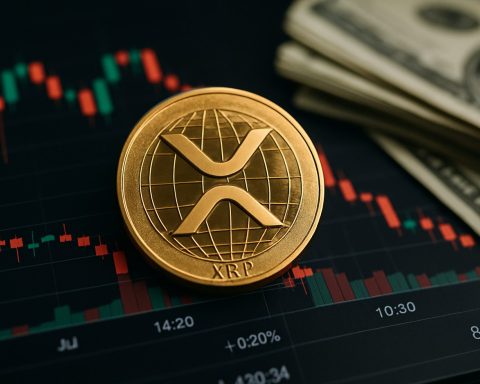- Ethereum (ETH) recently experienced a dramatic 20% drop, falling below the $1,500 mark, signaling its sharpest decline since March 2023.
- The decline was exacerbated by macroeconomic factors, including new tariffs disrupting financial markets.
- Over $400 million in Ethereum positions were liquidated, predominantly affecting long positions and decreasing futures open interest by 15%.
- A major investor suffered losses exceeding $100 million due to DeFi platform collateral issues.
- Ethereum’s first quarter of 2025 saw a 45% decline, losing about $170 billion in value, while fee income dropped significantly.
- The March 2024 EIP-1559 update unintentionally increased Ethereum’s inflationary pressures by reducing transaction fee burns.
- Analysts have moderated Ethereum’s price forecasts, with projections revised down to $4,000 by year-end 2024.
- Layer-2 solutions offering lower fees and faster transactions are increasing competition for Ethereum.
- Future upgrades like Pectra may strengthen Ethereum despite ongoing economic challenges and uncertainty.
Amidst the bustling world of digital currencies, Ethereum (ETH) recently plummeted below the psychological barrier of $1,500, shaking the very core of the cryptocurrency market. This dramatic 20% drop over 24 hours marks a critical juncture—the sharpest decline since March 2023—leaving analysts and investors alike searching for answers amidst the fallout.
The crypto landscape appears caught in the crossfire of macroeconomic upheavals. Market observers point to the fresh wave of tariffs unleashed by Donald Trump, which have rippled across financial markets, as a formidable adversary tightening the noose around Ethereum. As these tensions spread, Ethereum saw its value sink to $1,476, down from a 24-hour high of $1,799.
In the aftermath, the numbers speak for themselves: over $400 million in Ethereum positions were liquidated, with long positions taking a punishing hit of $341 million. This exodus sent shockwaves through Ethereum futures, which saw a marked decrease in open interest by a staggering 15%.
Caught in the storm was a prominent crypto whale, who took an estimated hit of over $100 million. This investor’s sizeable loan, underpinned by ETH on the DeFi platform Sky, faced automatic unwinding as the collateral value dropped, illustrating the merciless domino effect triggered by such market slides.
Despite this recent turbulence, Ethereum’s woes are not confined to the past 24 hours. Over the first quarter of 2025, the cryptocurrency witnessed a decline of 45%, hemorrhaging approximately $170 billion in value—marking it as Ethereum’s third-worst quarter since its creation in 2016. Even as it retained the lead in decentralized exchange trading volume in March, its fee income saw a sharp contraction, plummeting from $142 million in January to just $21 million in March, according to figures from DefiLlama.
These financial vicissitudes are intertwined with the March 2024 EIP-1559 update—dubbed the Dencun upgrade—which successfully diminished transaction fees but inadvertently propelled Ethereum back into an inflationary drift. The rate at which ETH was being burned, a key deflationary measure, has sunk to its lowest since August 2021.
This state of uncertainty has ushered in a wave of cautious optimism among analysts, who now scrutinize Ethereum’s trajectory with a keener eye. The bullish projections of 2024 have given way to tempered expectations, evidenced by Standard Chartered’s revision of its year-end price forecast from $10,000 to a more conservative $4,000.
Adding to the competitive landscape, Ethereum faces increasing pressure from layer-2 scaling solutions. These roll-ups are enticing users with promises of faster transactions and lower fees, sapping activity from the primary Ethereum network. Although the impending Pectra upgrade holds potential to fortify Ethereum’s foundational capabilities, the persistent shadow of global economic forces looms, ready to dampen any immediate recovery.
The saga of Ethereum serves as a stark reminder of the intricate web of influences shaping the fate of digital currencies. As this turbulent chapter unfolds, market participants remain on edge, acutely aware of the unpredictable nature of the crypto sea, ready for the next wave of change.
Ethereum’s Roller-Coaster Ride: What You Need to Know Now!
The recent plunge of Ethereum (ETH) below the $1,500 mark has sent ripples through the cryptocurrency market, highlighting several aspects that investors and analysts must consider. This dramatic decline, marked by a 20% drop in just 24 hours, emphasizes the vulnerability of digital currencies to broader economic and market forces. Here’s a deeper dive into factors influencing Ethereum and the broader crypto landscape, along with actionable insights for navigating this tumultuous market.
Factors Affecting Ethereum’s Volatility
1. Macroeconomic Challenges: Ethereum’s recent price drop can be partially attributed to macroeconomic tensions, notably the recent wave of tariffs initiated by Donald Trump. These geopolitical events have not only impacted global financial markets but have also tightened the squeeze on digital currencies.
2. DeFi Liquidations: The automated unwinding of Ethereum positions due to price declines highlights the risks embedded in leveraged DeFi platforms. A notable instance involved a crypto whale who suffered losses exceeding $100 million, showcasing the systemic risks of leveraging within decentralized finance.
3. Ethereum’s Past Performance: Ethereum’s history of sharp price movements includes a significant 45% decline over the first quarter of 2025, resulting in a substantial $170 billion loss in market value. Such volatility has been exacerbated by fees-related changes introduced in the EIP-1559 update, known as the Dencun Upgrade. Even though transaction fees have decreased, Ethereum has experienced a return to inflationary trends.
Industry Trends and Market Forecasts
– Rising Competition: Ethereum confronts increasing competition from layer-2 scaling solutions that promise faster transactions and reduced fees. These alternatives are drawing users away from the primary Ethereum network, further influencing its market performance.
– Updated Market Projections: Standards Chartered, reflecting the ongoing market volatility, has revised its year-end price forecast for Ethereum from an optimistic $10,000 to a more cautious $4,000.
How to Navigate the Ethereum Market
– Diversification: Investors should consider diversifying their crypto portfolios to mitigate risks associated with Ethereum’s volatility. Including stablecoins or other altcoins can help stabilize returns.
– Risk Management: Those engaged in DeFi platforms should practice vigilant risk management. Using stop-loss orders and understanding the implications of leveraged positions can avert significant losses during price downturns.
– Stay Informed: Keeping abreast of macroeconomic developments and technological updates within the Ethereum ecosystem is crucial. Changes in policy, such as tariffs, and advances in competitive technologies can significantly affect Ethereum’s price.
Insights and Predictions
As Ethereum navigates these turbulent waters, its long-term prospects remain tied to the broader economic context and technological advancements. The upcoming Pectra upgrade may serve as a significant leap forward in enhancing Ethereum’s core capabilities, potentially stabilizing its position amidst rising competition.
Pros and Cons Overview
Pros:
– Leader in decentralized exchange trading volume
– Strong developer ecosystem
– Potential upcoming upgrades (e.g., Pectra) to improve network capabilities
Cons:
– Increased competition from layer-2 solutions
– Vulnerability to macroeconomic factors
– Recent inflationary trend post-Dencun upgrade
Quick Tips for Investors
1. Monitor Upgrades: Keep an eye on the Pectra upgrade and other network developments, as these can provide insights into Ethereum’s future capabilities.
2. Market Sentiment: Gauge market sentiment through social media, forums, and expert commentary to better anticipate possible market moves.
3. Leverage Analytics: Utilize platforms like DefiLlama for fee and volume analytics to track Ethereum’s financial metrics over time.
For more insights into Ethereum and the cryptocurrency market, visit [CoinDesk](https://coindesk.com).
Conclusively, while the recent setbacks have tested Ethereum’s resilience, maintaining a long-term perspective and strategic approach can help investors weather the storm and capitalize on future opportunities.







